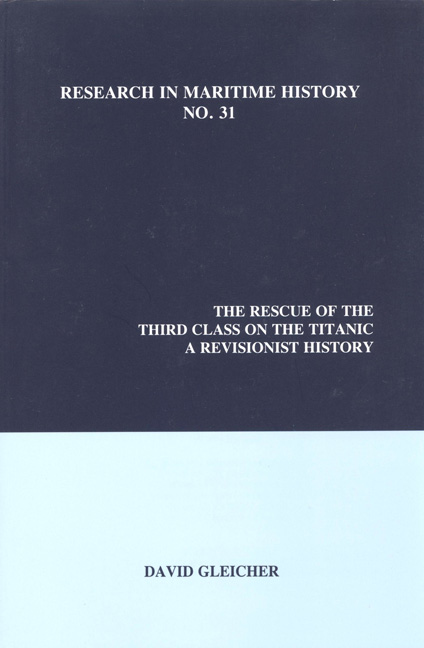Book contents
- Frontmatter
- Dedication
- Table of Contents
- List of Tables in the Text
- List of Illustrations
- Preface
- Notes on the Text
- Introduction
- Chapter 1 The “Popular Story”
- Chapter 2 The Nature Theatre of Oklahoma
- Chapter 3 Except the Rules
- Chapter 4 Departures
- Chapter 5 Like Wild Beasts Ready to Spring
- Chapter 6 Loose Ends
- Chapter 7 A Statistical Study
- Chapter 8 In Conclusion
- Appendix 1 Groupings of Nationalities into Regions
- Appendix 2 Routes to the Lifeboats
- Appendix 3 Deck Plans
- Bibliography
Chapter 1 - The “Popular Story”
- Frontmatter
- Dedication
- Table of Contents
- List of Tables in the Text
- List of Illustrations
- Preface
- Notes on the Text
- Introduction
- Chapter 1 The “Popular Story”
- Chapter 2 The Nature Theatre of Oklahoma
- Chapter 3 Except the Rules
- Chapter 4 Departures
- Chapter 5 Like Wild Beasts Ready to Spring
- Chapter 6 Loose Ends
- Chapter 7 A Statistical Study
- Chapter 8 In Conclusion
- Appendix 1 Groupings of Nationalities into Regions
- Appendix 2 Routes to the Lifeboats
- Appendix 3 Deck Plans
- Bibliography
Summary
Living Props and “Dangerous Individuals“
A discussion of the “popular story” and the Third Class passengers must necessarily be schematic, reflecting the nature of the event itself. The story is an impressionistic melange of anecdotes and narratives in the midst of a larger narrative. It centres around the First Class passengers and the top officers of the ship. In the “popular story” the Third Class passengers appear in a number of different guises, but most often not as themselves but rather as projections of the First Class passengers and the ship's officers. They are living props in a theatre of the elite, with the story set on the upper decks of the grandest ship ever built. The Third Class passenger may be an important element in the drama, but it is the tale of the elite that drives the story.
This is readily apparent in three “scenes,” akin to photographic stills, each of which has been nearly universal in films and books on Titanic since Walter Lord's classic A Night to Remember was published in 1955. In two of them the Third Class passengers collectively provide both comic relief - including opportunities for fictional love stories - and a foreshadowing effect. They are seen as a colourful and foreboding backdrop to what is going on above them. One is a festive scene of boisterous partying deep in steerage on the evenings of Titanic's passage, including 14 April. This has been portrayed in various films through particular ethnic groups - either Irish or Scandinavian, as a rule - replete with loud music, happy dancing and innocent flirtation, creating a cinematically effective, picturesque contrast to the restrained haute demeanor of the First Class passengers. The scene thereby establishes certain links between class, ethnicity and culture which form a fine web that clouds the “popular story.“
In the second scene, First Class passengers line the rails at the forward end of A Deck ten to fifteen minutes or so following the accident looking down on the forward Well Deck on C Deck. Games are being played by Third Class men using chunks of ice on the deck as footballs (see figure l). Whether this event actually occurred is in some doubt. There was no testimony about it directly at either of the two official inquiries that examined the event.
- Type
- Chapter
- Information
- The Rescue of the Third Class on the TitanicA Revisionist History, pp. 1 - 36Publisher: Liverpool University PressPrint publication year: 2006



